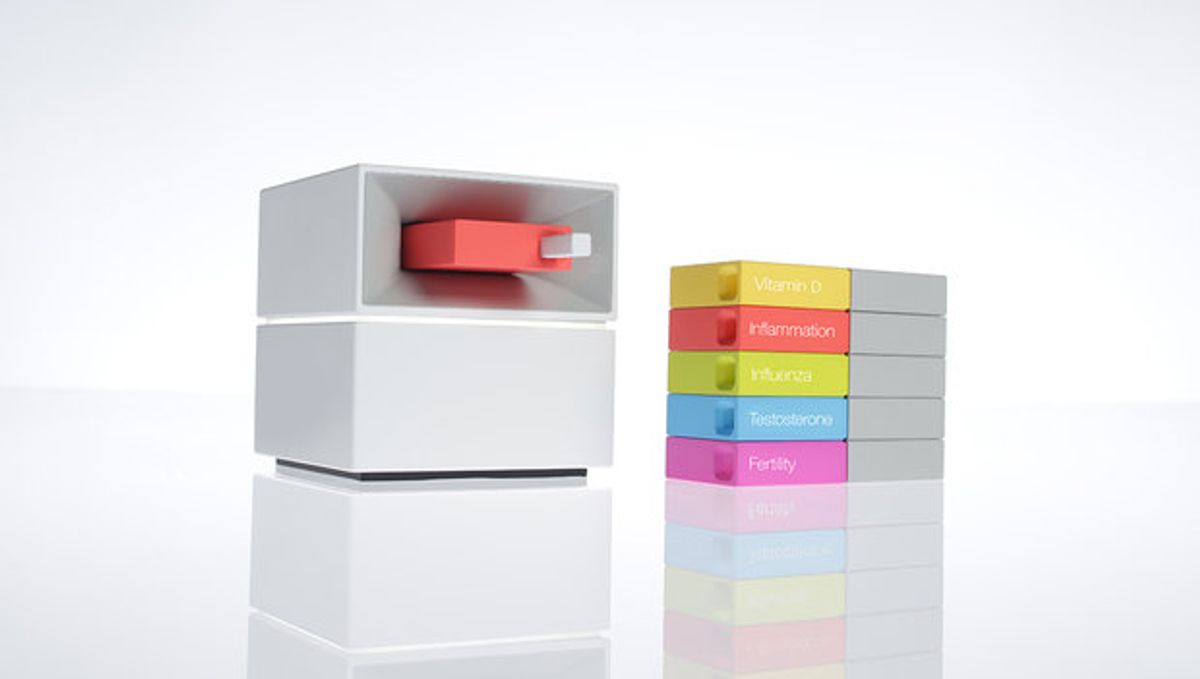Customers can pre-order the device beginning today, with shipping expected in spring 2015. At launch, Cue will be able to perform five different tests, but its makers say this is just the beginning. "The large majority of tests you do in the lab today, we want to give you access to in your own home," says Ayub Khattak, cofounder and CEO of the eponymous startup Cue.
Khattak sees his company as the next step forward for the quantified self movement, in which consumers are using various gizmos to count their steps, chart their blood pressure, monitor their sleep, and so on. But Cue goes beyond the easily collected metrics of health, and delves into biochemical markers.
For now, Cue offers the ability to test for testosterone, vitamin D, the flu virus, luteinizing hormone, which indicates a woman's fertility, and C-reactive protein, which serves as a marker of inflammation. That may seem like a rather hodgepodge selection, but Cue cofounder Clint Sever claims these are the most common tests run by labs, and they will therefore be of the most use to the public.
For each test, the device uses a different customized cartridge, which contains microfluidic channels and the necessary reagents. When a cartridge is inserted, Cue prompts the user to collect a sample with the included sample wand. The testosterone test requires saliva, the flu test needs a nasal swab, and the others require a drop of blood. It remains to be seen whether consumers will be willing to bleed themselves in their quests for optimum health. Khattak believes they will, and says that the use of a blood sample will give people faith in the test's validity. "If you want a real answer when you go to the doctor, that's where you get the answer from," he says.
Once the sample wand is inserted into the cartridge, Cue takes over. The reagents combine with the sample inside the cartridge, and a sensor looks for the target molecule (such as testosterone or vitamin D) and detects its quantity. Cue then transmits the information via Bluetooth to the user's smartphone (iPhone or Android). The smartphone app lets the user track results over time, and also offers suggestions for the user. If a man is trying to boost his testosterone, Sever says, Cue might recommend certain foods or exercises.
Despite the fact that one of the Cue cartridges detects the presence of the flu virus, the company's founders explain that it can't be considered a diagnostic device. At the moment, it's just an "investigational device" that consumers can experiment with, but the company is pursuing FDA approval. As for that flu test, Sever says the device isn't meant to replace a doctor's visit. "It just gives you more information so you can have an informed conversation with your doctor," he says. "It's like taking your temperature with a thermometer."
We've seen some remarkable examples lately of serious science packed into small consumer-electronics packages. Just a few weeks ago, we blogged about a hand-held spectrometer that people can use to examine the molecular content of their food. The engineering in these devices is undoubtedly impressive, but we're still waiting to see if these catch on as products. Cue might have a tough time because it requires users to keep buying single-use cartridges. It also seems a bit unlikely that users will be as dedicated to their Cues as the people are in the company's launch video, which shows, for example, a surfer on a beach checking his inflammation levels before catching a gnarly wave.
Eliza Strickland is a senior editor at IEEE Spectrum, where she covers AI, biomedical engineering, and other topics. She holds a master’s degree in journalism from Columbia University.




